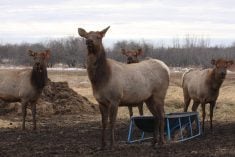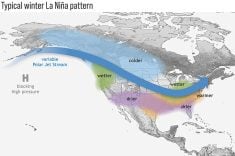Dr. Carol Haines breezes in and sketches out what she is spending a decade of her life trying to accomplish.
For her, breast cancer research is more than a physical and medical puzzle. It is also political.
Haines says her project not only raises the issues of lack of funding and the few studies into female illnesses, but also questions the entire approach of medical research. She wants to look at causes and attempt prevention, rather than deal with symptoms and treatment.
“No place in the world is doing this research,” she says.
Read Also

Canadian Food Inspection Agency extends chronic wasting disease control program consultation deadline
Date extended for consultation period of changes to CWD program
Haines was a country doctor before she went into full-time research. She came to Saskatchewan in 1990 from Maryland where she was a part-time professor at Johns Hopkins University.
“I’m aware of the strength in small towns and rural areas. I said I think people do want to help, to find the cause of breast cancer.”
Most studies try to track, after the disease has struck, what factors caused a woman to get cancer. This study does the opposite, she said.
“Very few of us are able to reliably recall, for example, how much cheese we ate in 1982 or how often after shaving we applied what type of underarm deodorants in 1991.”
According to statistics, one in nine women will get breast cancer.
The Canadian Cancer Society says no studies itemize rural people, so the factors of prairie environment, water or presence of agricultural chemicals are not evaluated.
That’s where Haines’ Saskatch-
ewan project will pick up the dropped stitches. At least two-thirds of the 75,000 women in the study are from outside Saskatoon and Regina.
“The small communities are the heart of our study. They have higher enrolment rates and better teams of volunteers.”
The volunteers phone women to come in and help them fill in their questionnaires by computer – often a donated one and located in hospitals, schools and health districts across Saskatchewan.
The most successful recruitments happen in communities of less than 600 people, Haines said. The volunteers are the heart and main support to the women’s commitment to the survey.
While the computers can seem overwhelming, the learning pulls on the “can-do approach of women in the Prairies.”
Haines won’t peek into the future and start analyzing the data to suggest answers yet. That could bias her findings and discredit the research.
In recognition of the fact this survey will not benefit the participants but may help their daughters, Haines and her staff of three are starting a 21st Century Girl Club.
They want to sign up girls born in the 1980s who will each recruit 10 adults and give them monthly facts in return for a loonie donation. It is not only an educational project but also could provide a small but steady stream of money to the breast cancer study, which flies on a shoestring budget with grants from various private foundations, service clubs and corporations.
“It really fits my vision of who we are, to get $2 from a lot of little people.”
Signing up
Rural women aged 22 to 75 can still join the survey by filling in the first and second years of the questionnaire. Call 306-664-4654 in Saskatoon for information.
Haines welcomes participants, saying there is an understandable drop-off in the commitment of the 75,000 initially recruited.
“They get sick, their parents die or they drive the soccer pool.”














